This Is How To Grow And Care For Hardy Geraniums According To Nursery Growers
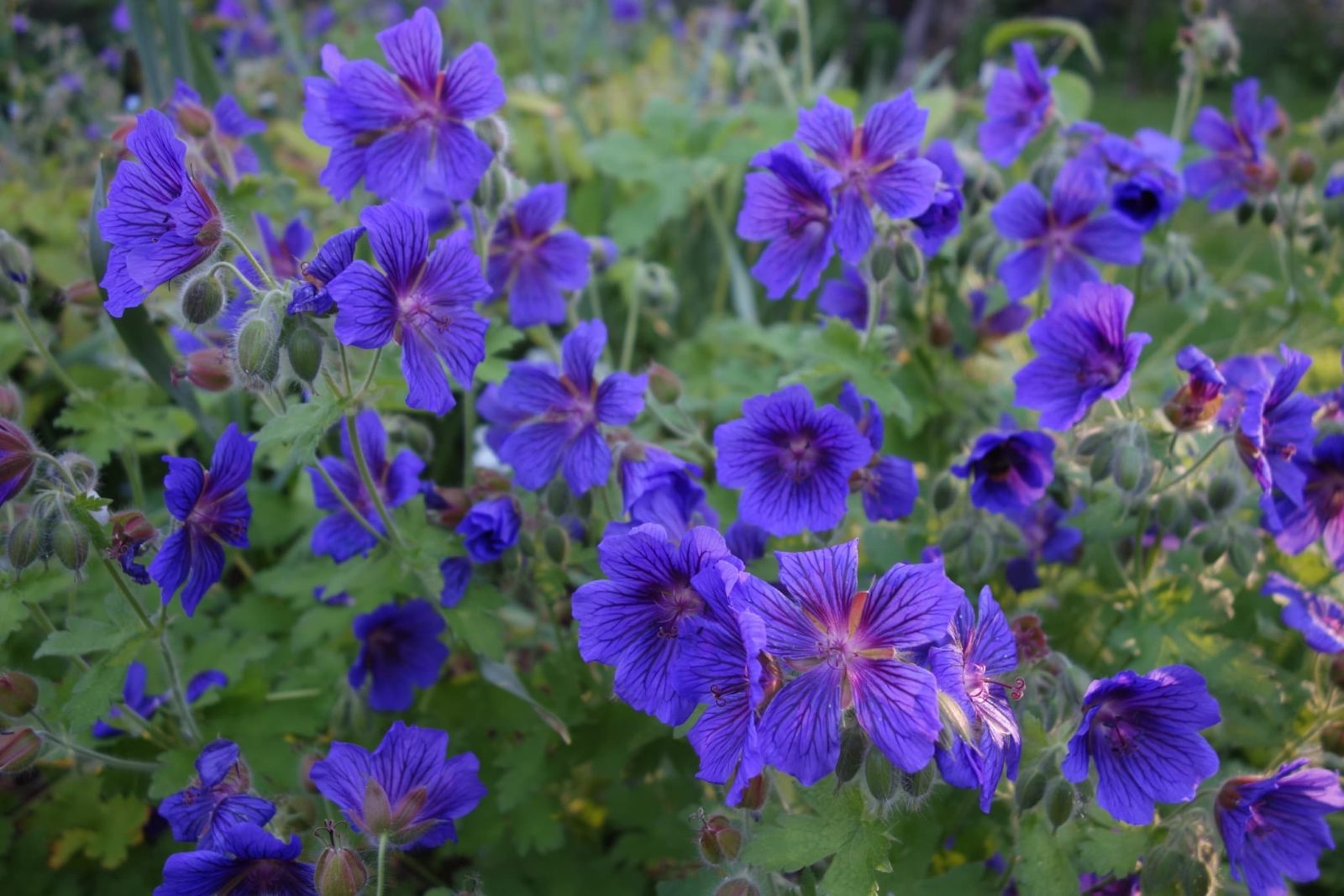
PERENNIALS > GERANIUMS
Reviewed By COLIN SKELLY

Colin is a Horticulturist and Horticultural Consultant with experience in a range of practical and managerial roles across heritage, commercial and public horticulture. He holds the Royal Horticultural Society’s Master of Horticulture award and has a particular interest in horticultural ecology and naturalistic planting for habitat and climate resilience.
Contributions From SUZIE DEWEY

Suzie is the Owner of the Hardy Geranium Nursery. She grew for two of the Main Avenue Show Gardens for the RHS Chelsea Flower Show 2015 - the gardens both won gold and one received Best in Show. She has also completed her RHS Level 3 Qualification.

Gary is the Owner of Cranesbill Nursery. He worked as a Gardener at the five star ‘Sails in the Desert’ hotel at Ayer’s Rock Resort in the outback and as a Gardener at the 17th Century National Trust property, Moseley Old Hall.

Lee Burkhill, better known as 'The Garden Ninja', is an RHS award-winning Garden Designer and TV Presenter who has worked on the BBC’s Garden Rescue for 4 years. Lee also posts regular design and garden tips to his YouTube channel and runs a blog where he connects with those in the community to answer any questions they might have. He trained at The Royal Botanic Garden Edinburgh.

Rosy Hardy is the Owner of Hardy’s Cottage Garden Plants. She has won 24 Gold Medals at the Chelsea Flower Show and 2 Tudor Roses at Hampton Court with her nursery. Rosy has been an honorary Vice President of the RHS since 2020 and is the author of the 2017 book ’25 Years of Chelsea’.
IN THIS GUIDE
The virtues of Hardy Geraniums are too numerous to reel off but suffice it to say that there must be solid reasons for these plants to be the United Kingdom’s favourite perennials.
Very many varieties are prolific and bloom for months on end, and the simple flowers exude a genuine charm all their own with their differing and delicate venations lending blooms a graceful refinement.
“I love hardy geraniums,” shares Rosy Hardy, Vice President of the RHS.
“They are the most useful plants you could grow in a garden because they are either dwarf, medium or tall and come in a good colour range. The only place you can’t grow them is a pond.
“If you’ve got a hardy geranium and need to fill a spot in a border, they are perfect.”
“Geraniums are super easy to grow and fuss-free and suitable for gardeners of all experience levels,” says Suzie, who opened her nursery in 2018.
“They require minimal maintenance and are also generally pest and disease resistant.”
The Geranium genus has a vast habitat that spans all climatic zones, yet this remarkable range is exceeded by the popularity of this plant.
And for good reasons: a majority of varieties are perennial, as many are hardy, a large number bloom all summer long, they are so easy to grow, and they boast truly delightful flowers!
Overview
| Botanical Name | Geranium |
| Common Name(s) | Cranesbill |
| Plant Type | Perennial / Annual Flower |
| Native Area | Europe |
| Hardiness Rating | H6-H7 |
| Foliage | Deciduous |
| Flowers | Rounded, 5 petalled flowers in various hues |
| When To Sow | January, February, November, December |
| Flowering Months | April, May, June, July, August, September |
Sunlight
Preferred
Full shade or partial shade, some even in deep shade
Exposure
Exposed or Sheltered
Size
Height
0.5 – 1M
Spread
0.5 – 1M
Bloom Time
June – September
Soil
Preferred
Most Soil Types
Moisture
Moist but well drained
pH
Any
“Geraniums come from all over the globe so it’s possible to find a Geranium for almost any part of the garden, whether that’s in sun or shade, or wet or dry soil, and most situations in between,” shares Gary, who has experience gardening on opposite sides of the world.
“There are ones that grow up to four feet and ones that only grow to six inches. There are types that can pretty much give year-round interest and there are also types suitable for containers.
“The vast majority of them are hardy down to -15°C.”
The Geranium genus includes 358 species according to Kew Royal Botanic Gardens, and many more cultivars with almost all the in-demand varieties being perennials.1Geranium Tourn. ex L. (n.d.). Kew Royal Botanic Gardens. Retrieved March 15, 2023, from https://powo.science.kew.org/taxon/urn:lsid:ipni.org:names:327764-2#children

These plants are also called ‘Cranesbills’ because the seed capsule of many species brings to mind a crane’s bill.
These capsules exhibit one of the more interesting and dynamic Botanical mechanisms related to seed dispersion.
When the seeds within a capsule are mature, the capsule bursts open and throws out the seeds.
Geraniums also possess other traits that are exciting, especially for hobbyist gardeners.
Geraniums vs Pelargoniums
Geraniums belong to Family Geraniaceae as do the closely-related Pelargoniums.2Geraniaceae Juss. (n.d.-b). Kew Royal Botanic Gardens. Retrieved March 9, 2023, from https://powo.science.kew.org/taxon/urn:lsid:ipni.org:names:30001521-2
Originally the species of both genera were classed together in Genus Geranium.

Although they were separated and reclassified into genera Geranium and Pelargonium over two centuries ago, plants of the latter genus are sometimes still considered and called Geraniums.3Mentary, L. (2020, December 28). The Difference Between Geraniums and Pelargoniums. Rozanne and Friends®. Retrieved March 9, 2023, from https://www.geraniumrozanne.com/geraniums-and-pelargoniums/
As a result, to differentiate between the two, Geraniums proper are often called ‘Hardy Geraniums’ or ‘True Geraniums’.
“If you’d prefer to use the name Geranium for Pelargonium, the RHS recommends referring to them as ‘tender Geraniums’ to distinguish them from true hardy Geraniums,” adds Colin Skelly.
This article does not cover Pelargonium.
Habitat & Growing Conditions
Geranium is so varied a genus and its species cover an abundance of regions and biomes that they are found in every conceivable habitat except the tundra.
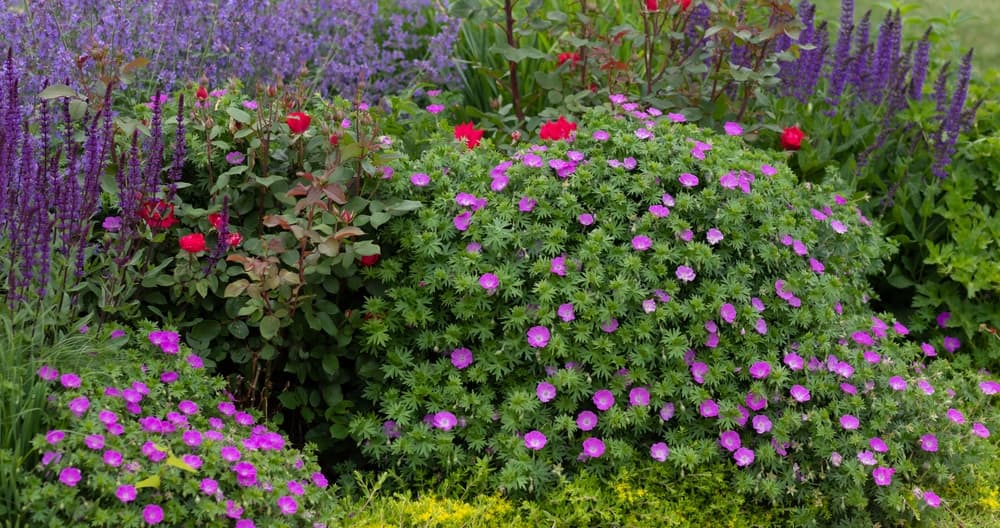
Some species grow at sea level while others thrive on high mountains.
For example, G. robertianum flourishes in coastal areas while G. nodosum does equally well on alpine slopes.
Some species prefer open fields and full sun while others prefer woodland shade though it is safe to say that part sun suits most species very well.
These plants make do with any type of soil so long as it is not waterlogged or overly alkaline.
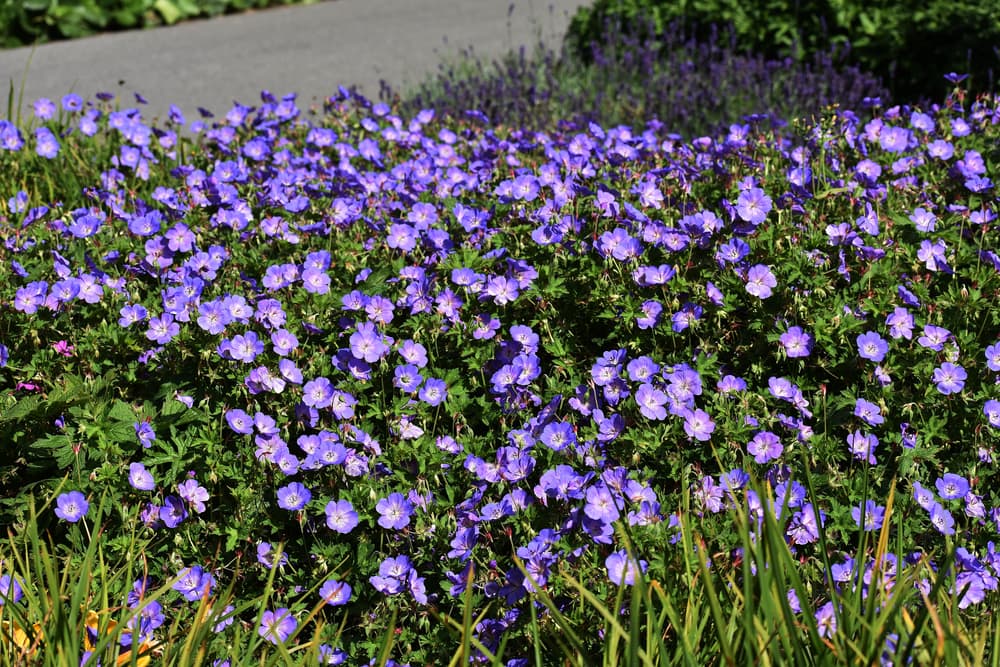
As the genus is so varied and as its species inhabit just about every climatic zone and biome, species’ RHS Hardiness Ratings vary widely.
In the UK the native species are found in meadows (Geranium pratense), woodlands (Geranium sylvaticum), littoral regions and even on sand dunes (Geranium sanguineum).
How To Grow Geraniums
First, keep in mind that Geraniums are unusually easy to propagate yourself, and that too in three different ways:

- Plants can be propagated by division and also by cuttings.
- Seeds are simple to obtain by harvesting seed capsules – although the seedlings may not be true to the parent cultivar.
- Geraniums are among the most widely available of plants.
All the established varieties are available at brick-and-mortar garden centres and also from online retailers, with a few varieties sold by dozens of sellers.
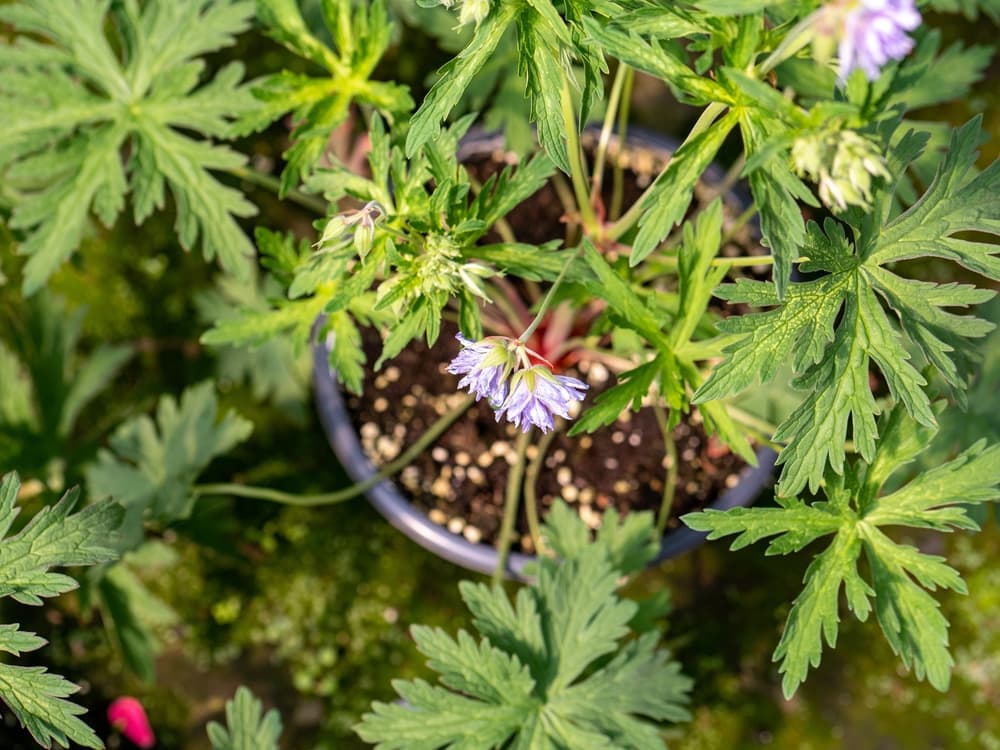
Both potted plants and seed packets are equally easy to find.
Planting
Considering the considerable range in varieties’ heights and spreads, and the fact that they come in all habits and forms, just where a Geranium variety is best planted strongly depends on its characteristics.
Consider that G. ‘Mavis Simpson’ grows to all of 20cm, if even that, and is mat-forming, while G. ‘Orion’ is over five times as tall and with a bushy habit.

Selecting the right plant for the right location is one of the most important care factors according to Suzie.
“If you select a plant for a sunny spot that is better suited to a shady spot, it will grow, but it will not thrive.
“Fortunately, there are hundreds of different geraniums to choose from, so it’s very easy to find something suitable for every corner of your garden.”
Most varieties make for superlative beds, borders, and edges.
The few mat-forming varieties are excellent choices for attractive groundcover while clumping varieties provide splashes of colour in rock gardens.
A majority of Geranium varieties are of that intermediate height such that in formal gardens they can be matched with taller plants like rhododendrons to set them off, yet can also be used behind smaller ornamentals like pansies.
Plants of this varied and versatile genus can be displayed in a planter on the patio, in pots on a parapet, in hanging baskets on a pergola and much more.
Geranium Plant Care
“If you’re looking to grow Hardy Geraniums for the first time, you really would do well to find an easier plant to grow,” says Gary.
Among the most unfussy and undemanding of flowering plants, Geraniums will grow in just about any soil and with next to no care.

Though this is a simple statement of fact, it should not be misconstrued to suggest that you may neglect your Geranium.
For healthy, long-lived plants that adorn your garden with an abundance of blooms for the longest possible flowering season, here are some simple tips:
Soil Requirements
Plant Geraniums in any fertile loam mix that contains humus or organic manure.
If planting in a pot use a peat-free potting compost or a loam-based compost such as John Innes no. 2.
If planting in the soil, geraniums suit many soil conditions but should have good drainage and the ideal soil pH range for most varieties is from 6.0 to 6.5 – Slightly Acidic.
Sunlight & Temperature
A majority of Geraniums prefer full sun to part sun whereas some prefer full shade to part shade.
A few very sporting varieties, such as G. phaeum var. phaeum ‘Langthorns Blue’ and G. ‘Melinda’, will flourish in full sun through full shade!

Most Geraniums will grow well where they get full sun until around 1PM and shade or dappled sunlight thereafter.
In the United Kingdom, temperature ranges are not a concern for Hardy Geraniums, although they may wilt in prolonged dry weather in sandy soil.
Harvesting Seeds
“Geraniums can tend to self-seed, some more than others,” explains Gary when discussing some of the drawbacks of growing geraniums in the garden.
This can be a great thing if you want your geraniums to self-propagate, but not so great if you like a bit more control in your outdoor spaces.
“Luckily, this can largely be avoided by going for sterile hybrids.”
Keep in mind that it is particularly straightforward to collect Geranium seeds by harvesting the capsules.
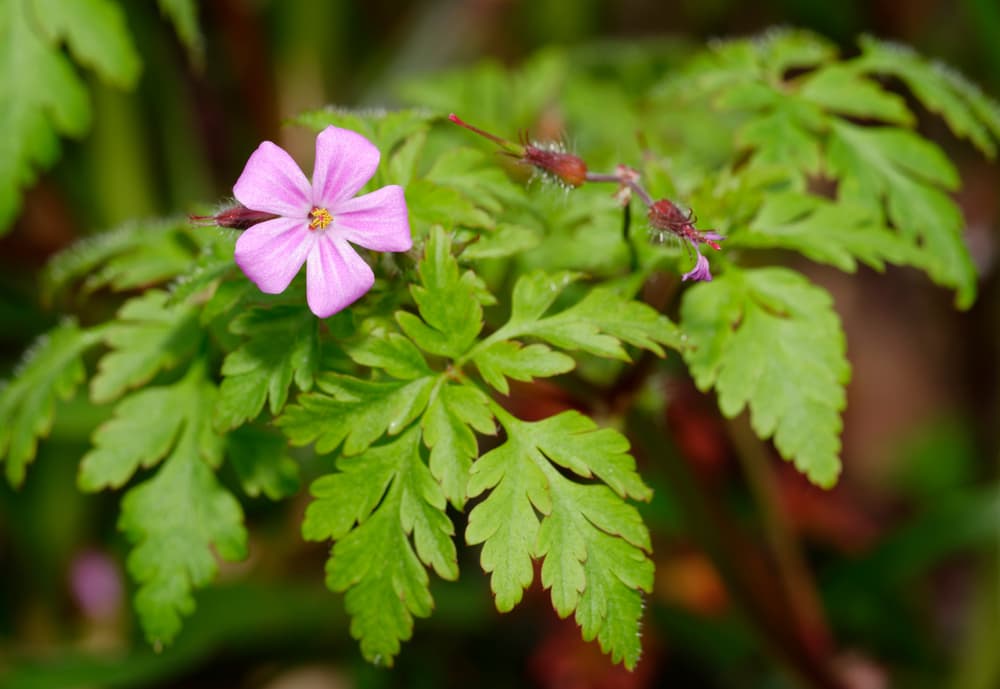
To plant seeds, nudge them into the earth and cover with a thin sprinkling of soil.
Water well and then continue to water every two days or so, so as to keep the soil moist as the seedling matures, tapering off as the plant grows.
Common Problems
For the most part, Geraniums are healthy low-care plants.
However, now and again a plant can be attacked by vine weevil, geranium sawfly, or capsid bug.
The diseases that Geraniums have a particular susceptibility to are limited to downy mildew and powdery mildew.
“Encouraging good air circulation between plants, watering early in the day and avoiding watering the leaves will help to prevent powdery mildew,” advises Suzie.
Exceptional Geranium Properties
The visual appeal of these plants begin with the foliage.
Be the leaves a medium or dark shade of green, the colour is almost always rich and deep with some having a shiny lamina.
What is more, come autumn, many varieties’ leaves become tinged with red, bronze, or golden-yellow or even change colour entirely.

The leaves also have a pretty shape, being oval to round, and palmately lobed, often deeply.
As it happens, in a show of sympathy and artistic symmetry with the lobed leaves, many Geranium flowers’ petals are notched at the distal borders, some quite deeply.
The lovely five-petalled flowers are bowl-shaped, salver-shaped, or flatly disk-shaped.
Their colours fall in the red-to-blue spectrum with the hue ranging from very pale to vibrantly intense, from a pinkish-white to brilliant violet.
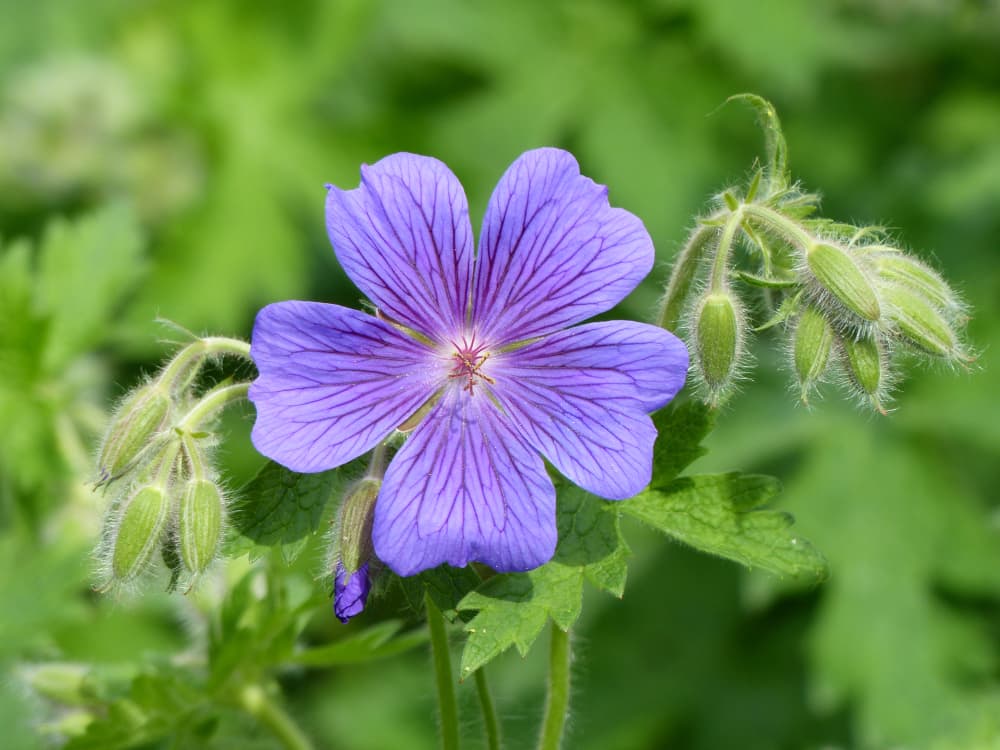
A feature typical of Geranium flowers is the well-known delicate radial veining along the petals.
To cap off their attractions, a majority of Geraniums draw bees and butterflies.
Geraniums are one of the most popular plants for beds and borders but they also make wonderful container plants for the windowsill and balcony.
“You can pop geraniums in a pot, they don’t get huge and they bulk up quickly,” shares Lee Burkhill, an award-winning Garden Designer.
“These plants can tolerate abuse, so start with the basics and once you get that right, you can start to bulk up on your collections.”
Considering that a majority produce blooms for the whole summer with a significant number extending their flowering season deep into autumn, with other varieties getting the show underway sometime in spring, it is no wonder that Geraniums are the United Kingdom’s favourite perennial plants.
References
- 1Geranium Tourn. ex L. (n.d.). Kew Royal Botanic Gardens. Retrieved March 15, 2023, from https://powo.science.kew.org/taxon/urn:lsid:ipni.org:names:327764-2#children
- 2Geraniaceae Juss. (n.d.-b). Kew Royal Botanic Gardens. Retrieved March 9, 2023, from https://powo.science.kew.org/taxon/urn:lsid:ipni.org:names:30001521-2
- 3Mentary, L. (2020, December 28). The Difference Between Geraniums and Pelargoniums. Rozanne and Friends®. Retrieved March 9, 2023, from https://www.geraniumrozanne.com/geraniums-and-pelargoniums/

